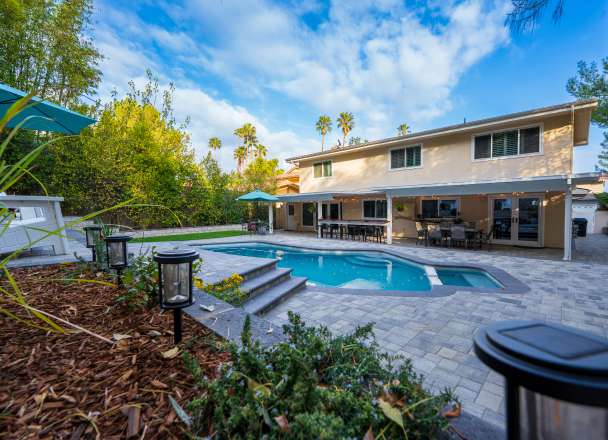Grants vs. Loans for ADU: A Comprehensive Savings Guide
- #Outdoor Living

- Smooth Plaster Finish
- Shimmering Pebble Finish
Grants reduce upfront costs for ADUs without repayment, while loans leverage home equity or future value but require repayment with interest. Combining both maximizes financial flexibility and minimizes out-of-pocket expenses.
Understanding ADU Financing Options
When planning to build an Accessory Dwelling Unit (ADU) like a granny flat or garage conversion, knowing your financing options is crucial. There are two main options: grants and loans. Each has its benefits and considerations.
Grants:
- Cost Savings: Grants can significantly reduce expenses for design and permits.
- Example: The California Housing Finance Agency’s ADU grant offers $40,000 to eligible residents, covering “soft costs” without repayment. For more information on the program, check out the details of the ADU Grant Program in Los Angeles.
- Income Requirements: Qualifying for grants often depends on income levels, which can vary by region.
Loans:
- Types of Loans:
- RenoFi Loans: These consider your home’s future value post-construction, allowing larger borrowing amounts at favorable rates. Options include Home Equity Loans, HELOCs (Home Equity Lines of Credit), and Cash-out Refinancing.
- HELOCs and Home Equity Loans: HELOCs provide a revolving line of credit with variable rates, while Home Equity Loans offer fixed amounts with set schedules, typically at higher rates than your primary mortgage.
- Cash-Out Refinance: Refinances your existing mortgage using built-up equity to finance the ADU. Best for those with significant equity, though it usually involves higher rates and closing costs.
- Construction Loans: Previously popular but now less favored due to high closing costs and complex requirements. Suitable for large-scale projects requiring detailed procedures and refinancing.
- Unsecured Personal Loans or Credit Cards: Generally not advisable due to high interest rates, but can be used for small-scale projects or as gap financing.
Securing an ADU Loan:
- Determine Budget: Assess the loan amount needed by consulting financial advisors and contractors.
- Assess Eligibility: Use calculators to check borrowing capacity, considering debt-to-income ratio, credit score, and annual income.
- Research Lenders: Compare offers from different lenders to find the best rates and terms.
- Gather Documentation: Prepare necessary documents for loan applications.
- Apply for Loan: Submit the loan application to the chosen lender.
Investment Considerations:
- Return on Investment (ROI): Building an ADU can increase property value and generate rental income. In high-demand areas like California, homes with ADUs can be priced significantly higher. Discover more about the ROI of ADU Investments in Calabasas.
- Long-Term Gains: Compare potential rental income to project costs for a clear ROI evaluation.
Understanding these financing options helps you make informed decisions for your ADU project, optimizing your financial resources effectively.

Types of Grants Available for ADU Construction
This section will explore the various grants available for ADU construction, including eligibility criteria and the application process.
California offers an ADU Grant Program aimed at increasing housing through accessory dwelling units (ADUs). Homeowners can receive grants up to $40,000 to cover pre-development and non-recurring closing costs, such as:
- Site preparation
- Architectural designs
- Permits
- Soil tests
- Impact fees
- Property surveys
- Energy reports
Eligibility criteria for the ADU Grant Program include:
- Primary residency of the homeowner
- Compliance with local zoning laws
- Meeting income restrictions
- Proof of property ownership and insurance
The application process involves several steps:
- Identify a suitable grant.
- Gather necessary documentation.
- Complete the application meticulously.
- Adhere to deadlines.
- Wait through the review period.
Successful applicants benefit from financial support but should be aware of potential increases in property taxes due to higher property value post-construction.
Building an ADU offers multiple benefits, such as generating rental income, providing housing for family members, or creating personal spaces like home offices. Each option comes with its own set of considerations, including tax implications and rental regulations.
Loans: Traditional and Specialized ADU Loans
Traditional loans and specialized ADU loans offer various ways to finance the construction of an Accessory Dwelling Unit, each with unique benefits and drawbacks.
Traditional Loans: Traditional loans like Home Equity Loans and Home Equity Lines of Credit (HELOCs) allow homeowners to use their existing home equity as collateral. These loans are popular but require significant built-up equity.
Advantages:
- Provides funds to start construction without delay.
- Can increase property value.
- Offers potential rental income to offset loan payments.
Drawbacks:
- Adds financial burden with additional monthly payments.
- Interest rates can substantially increase overall costs.
- Home is used as collateral, posing foreclosure risks if repayments are missed.
Specialized ADU Loans: Specialized ADU loans, such as RenoFi Loans, consider the future value of the home post-construction. This allows homeowners to borrow more without refinancing the primary mortgage.
Types of Specialized Loans:
- RenoFi Home Equity Loan: Offers a fixed rate without refinancing.
- RenoFi Home Equity Line of Credit: Provides flexible withdrawal options.
- RenoFi Cash-Out Refinance: Allows drawing from the new ADU’s equity.
Construction Loans: These loans finance ADUs based on future home values but may require refinancing after construction. They come with stringent requirements, making them less ideal compared to RenoFi Loans.
Unsecured Personal Loans and Credit Cards: While these options are available, they generally have high-interest rates and strict borrower requirements, making them costly and less suitable for ADU projects.
Steps to Securing an ADU Loan:
- Determine loan amount by establishing a budget and getting contractor estimates.
- Assess eligibility using mortgage calculators.
- Research lenders to compare rates and programs.
- Gather necessary financial documentation.
- Apply for the loan and verify information with lenders.
Final Considerations: Building an ADU can significantly increase property value and offer rental income. Homeowners should carefully weigh their loan options, considering long-term financial goals and investment potential. Consult with knowledgeable lenders and financial advisors to make an informed decision.

Maximizing Savings: Combining Grants and Loans
To effectively combine grants and loans for your ADU project, strategic planning is paramount. By leveraging available resources, you can significantly reduce out-of-pocket expenses and maximize savings.
Start by exploring local government grants. Many city and state programs offer substantial financial support:
- Grants up to $40,000 for expenses like site preparation, architectural design, and permits. For tips on how to qualify, visit How to Qualify for the CalHFA ADU Grant Program.
Pairing these grants with suitable loans can further stretch your budget. Consider these popular loan options:
- Home Equity Lines of Credit (HELOCs) based on future home value—tap into more equity.
- Cash-Out Refinancing based on post-construction value—ideal if current equity is insufficient.
- Fannie Mae HomeStyle® Renovation—finance based on the property’s as-completed value.
- Freddie Mac CHOICERenovation℠—another flexible option for financing ADUs.
- FHA 203k Loans—borrow up to 97.75% of future value, including potential rental income.
Combining both grants and loans can help you cover different aspects of your project. Use grants for initial costs like planning and permitting, and loans for construction phases to manage out-of-pocket expenses effectively.
By understanding and utilizing these strategies, you can efficiently finance your ADU project. For more information on services, EHD Builders offers expert guidance and free estimates to help get your project started.

FAQ
What are the two main financing options for building an ADU?
The two main financing options for building an ADU are grants and loans, each offering unique benefits and considerations.
What are the benefits of grants for ADU construction?
Grants can significantly reduce expenses for design, permits, and other pre-development costs without requiring repayment. An example is the California Housing Finance Agency’s ADU grant, which offers $40,000 to eligible residents.
What are the typical eligibility criteria for ADU grants?
Eligibility for ADU grants often depends on factors such as income levels, primary residency of the homeowner, compliance with local zoning laws, and proof of property ownership and insurance.
What types of loans are available for ADU construction?
Various loan options include RenoFi Loans, Home Equity Loans, HELOCs, Cash-Out Refinancing, Construction Loans, and even Unsecured Personal Loans or Credit Cards.
What are RenoFi Loans, and why are they beneficial?
RenoFi Loans consider the future value of the home post-ADU construction, allowing for larger borrowing amounts at favorable rates. Types include Home Equity Loans, HELOCs, and Cash-Out Refinancing.
What is the process for securing an ADU loan?
The process involves determining your budget, assessing eligibility, researching lenders, gathering necessary documentation, and applying for the loan.
How can building an ADU provide a return on investment (ROI)?
Building an ADU can increase property value and generate rental income. In high-demand areas, homes with ADUs can be priced significantly higher, offering long-term financial benefits.
What are the steps in the ADU grant application process?
The application process typically includes identifying a suitable grant, gathering necessary documentation, completing the application meticulously, adhering to deadlines, and waiting through the review period.
What are the advantages and drawbacks of traditional loans for ADU construction?
Advantages include immediate funds for construction, potential property value increase, and offsetting loan payments with rental income. Drawbacks involve additional monthly payments, higher overall costs due to interest, and foreclosure risks if repayments are missed.
How can homeowners maximize savings by combining grants and loans for their ADU project?
Combining grants and loans can stretch your budget by using grants for initial costs like planning and permitting and loans for construction phases. This strategic planning can significantly reduce out-of-pocket expenses.
What resources and services can assist homeowners in financing their ADU project?
Homeowners can explore resources like local government grants and various loan options while consulting with financial advisors and lenders. Expert guidance and free estimates are also available from builders like EHD Builders.
Sources
This article utilized various sources including NerdWallet, Realtor, California Housing Finance Agency (CalHFA), Mortgage Research, and The Mortgage Reports to provide insights on financing options for ADUs. For additional information, please refer to the respective links.









